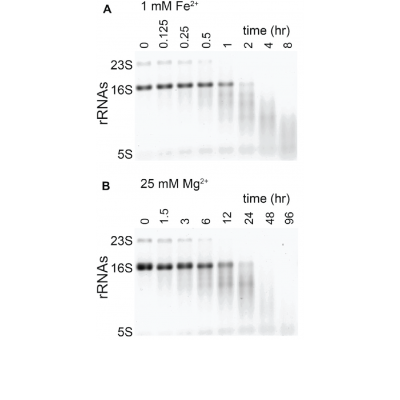
Ribosomes originated long before the Great Oxidation Event (GOE) and their structure and function are strongly dependent on divalent metals (M2+). Thus, understanding ribosomal evolution requires characterization of ribosomal interactions with M2+ ions under pre-GOE conditions: in the presence of abundant Fe2+ and in the absence of O2. Here, we have shown for the first time that bacteria grown in these conditions contain functional ribosomes with tightly bound Fe atoms. We observe Fe2+ can exchange with Mg2+ (and vice versa) during purification; but, a small fraction of the associated Fe2+ is not exchangeable, presumably because those ions are tightly coordinated by rRNA and deeply buried in the ribosome. In extant aerobic life, Mg2+ appears to be the primary M2+ ion in translation and can facilitate RNA folding and assembly, but also cuts RNA by in-line cleavage. Before GOE, anoxia would have stabilized Fe2+ for such interactions, yet Fe2+’s activity with RNA is still poorly understood. We recently reported that anoxic Fe2+ can fold RNA and mediate in vitro translation under pre-GOE conditions, albeit at a lower rate compared to Mg2+. Here we show that anoxic Fe2+ cleaves RNA far more rapidly and extensively than Mg2+. Our experiments showed nearly identical banding patterns and cleavage reaction products for Mg2+ and anoxic Fe2+, pointing to a common in-line cleavage mechanism. The cleavage potency of Fe2+ may lead to decreased longevity of Fe2+-containing ribosomes. These results have significant implications for the evolution of RNA and iron toxicity in disease. The balance between insufficient and excessive M2+ may be at a lower concentration for Fe2+ relative to Mg2+, potentially conditioning RNA to access more functions using less metal while the high cleavage activity of Fe2+ could cause rapid recycling of RNA especially for unstable molecules. Therefore, Fe2+ may have been a force for accelerated RNA evolution on early Earth.
Guth-Metzler, R., Bray, M. S., Frenkel-Pinter, M., Suttapitugsakul, S., Montllor-Albalate, C., Bowman, J. C., Wu, R., Reddi, A. R., Okafor, C. D., Glass, J. B., & Williams, L. D. (2020). Cutting in-line with iron: ribosomal function and non-oxidative RNA cleavage. Nucleic acids research, 48(15), 8663–8674. https://doi.org/10.1093/nar/gkaa586
